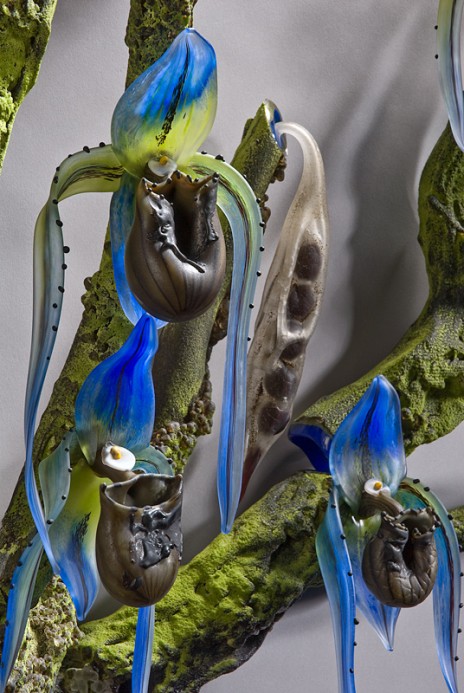#feministfriday episode 439 | Orchids
Good morning everyone,
Let me tell you about one of the nicest gifts I have ever recieved. This was about five, six years ago now, I was leaving a job and I was sad to be leaving. One of my team bought me a gift, an orchid. It arrived in the post which firstly was great, I love getting post, and of course when it arrived it was just perfectly in flower like orchids always are when they arrive. I'd assumed that the flowers would last for ages but that afterwards that would just be it, it would never flower again. Every November since then, though, it's put out a stalk and flowered its little heart out in the dead of winter, and with that I remember always the kindness of the person who sent it to me as well as appreciating the foamy wonder of this plant on my windowsill.
That is why this Fem Fri is about orchids.
Debora Moore is an incredibly accomplished glass artist who has devoted her career to the orchid. She learned glassblowing as a single parent and has gone on to great acheivements like residencies in Murano:

“A rose is a rose, but an orchid is — I don’t know,” she said, laughing about the bounty of orchid species. “I would never live long enough to make all of them.” Orchids have been a longtime muse of Moore’s. Some pieces in the exhibit are from as far back as 1987, when she had just begun to blow glass. She called “Glass Orchidarium” a “collection, within a collection, within a collection.”
https://www.seattletimes.com/entertainment/visual-arts/fragile-beauty-the-glass-art-of-debora-moore/
How about amateur scientist Edith Coleman, who by watching a wasp on an orchid with her kid made a major discovery on how these flower are pollinated:
Coleman's biggest achievement was her discovery of "pseudocopulation", a pollination strategy that has a plant – especially an orchid – mimicking a sexually receptive insect, thereby tricking male insects into mating with it. Coleman's pseudocopulation discovery trail was long and involved. It began in January 1927, when one of her daughters described how she had seen a wasp entering the flower of the small tongue orchid (Cryptostylis leptochila) backwards. Coleman and her daughter then observed this "perplexing" behaviour time and again.

https://www.smh.com.au/entertainment/celebrating-melbournes-housewife-naturalist-20180404-h0yb2l.html
More science and more breakthroughs - here is Melissa McCormick talking about what can make an orchid come out of hiding:

Scientists have long puzzled over what prompts the plants to switch from a state of dormancy and send up shoots. Now, a new study by a group of scientists from the Smithsonian Environmental Research Center in Edgewater, Maryland, explains how concentrations of certain fungus in the soil cause one North American species of orchid, the small-whorled pogonia, to awaken.
https://www.smithsonianmag.com/smithsonian-institution/mystery-hiding-orchids-solved-180961773/
Have a wonderful Friday <3
Alex.